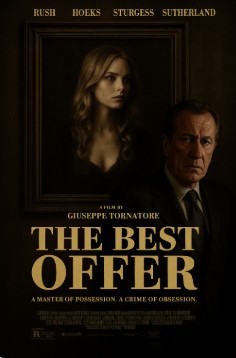Giuseppe Tornatore’s The Best Offer
A lyrical journey into Giuseppe Tornatore’s The Best Offer, where art collecting becomes a meditation on authenticity and the bittersweet peril of safeguarding beauty until it slips beyond the reach of life itself.
CIACK D'ATELIER
Charlotte Madeleine CASTELLI
8/10/20252 min read


The Collector’s Blind Spot: On Giuseppe Tornatore’s The Best Offer
The first time I encountered Giuseppe Tornatore’s The Best Offer, I felt as though I had stepped into a gallery I knew well, only to have one of its paintings reveal a hidden detail—something I’d passed over countless times but could no longer unsee. That sensation came, I think, from recognising myself in the film’s protagonist, Virgil Oldman: a man who lives to catalogue, to evaluate, to guard. His relationship to art is not unlike my own—precise, protective, and quietly obsessive.
Virgil orders the world the way an auction catalogue orders its lots: methodically, elegantly, with a kind of ruthless discernment. For him, value lies not in market prices but in the triangulation of authenticity, provenance, and historical significance. The female portraits that line his private vault are not commodities—they are confidantes. Silent, constant, and, unlike living people, utterly reliable. In Virgil’s impulse to shield beauty from the chaos beyond the frame, I recognised the double edge of connoisseurship: the desire to preserve, and the temptation to retreat entirely into a reality of one’s own making.
Tornatore’s great tension lies in the interplay between seeing and possessing. The portraits in Virgil’s vault promise permanence; they freeze identity into an eternal pose. Yet the man who can unmask a forgery with a glance is blind to the deception that unfolds in front of him. His eye—so sure in the realm of pigments and patina—falters in the presence of emotion. I know that failure intimately: the way knowledge can be eclipsed by the wish to believe. Expertise cannot guard you against a perfectly crafted illusion, especially when you want it to be real.
Virgil’s home is a theatre of controlled beauty: the climate-controlled vault, the gloves laid out like surgical instruments, the careful choreography of light on varnish. Watching Tornatore’s camera linger over these details, I saw not just the discipline of a curator but also the isolation that such discipline can conceal.
Then there is Claire, the reclusive young woman whose fragility and mystery seem to slip seamlessly from the painted world into the living one. I could not decide whether Virgil loved her, or loved the idea of her—another portrait for the vault, another perfect composition. It is a question I’ve asked myself before: are we drawn to people, or to the narratives we’ve already written about them?
The Best Offer pivots on the question of authenticity—technical and emotional. Virgil triumphs at the first, and collapses at the second. His public auctions and private vaults are two sides of the collecting instinct: the performative display and the solitary communion. I’ve seen this in the art world often enough—the way spaces of exchange can so easily transform into spaces of possession.
By the film’s close, deception has stripped Virgil of everything but his hunger for beauty. And yet I found myself feeling something dangerously close to empathy. The prison he inhabits is one he built himself—ornate, immaculate, and unshakably his. Perhaps that is the quiet tragedy of the collector: to love an object enough to protect it from the world, but never enough to release it back into it. Tornatore leaves us with a portrait not just of a man undone by a con, but of a sensibility—a curator’s, a collector’s, perhaps even my own—that cannot help but frame the world, even as it is being framed in return.
© Charlotte Madeleine Castelli | All rights reserved
